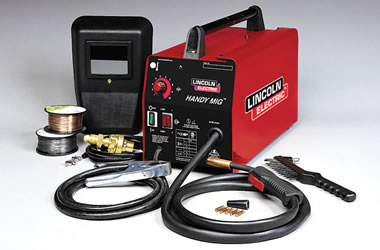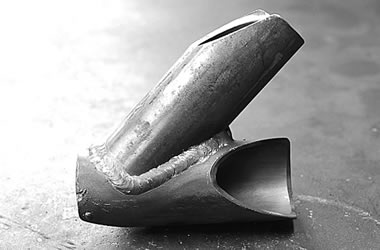So you took (or are about to take) the plunge and got a MIG welder. Not only will you be able to make brackets, stitch together body panels, and fix broken parts for yourself, you’ll have the honor of doing it for your car pals, too.
We know you’re probably itching to fire up that new welder and make stuff. But before you begin, we have some handy tips, courtesy of the welder folks at Lincoln Electric, to help you get your fabricating career off to a good start. While this info is geared to the new welder, you guys that have been making the sparks fly for awhile might learn a little something too.
What Can I Weld?
Most home shops have a machine similar to Lincoln’s Handy MIG, a household current (115 volt) portable unit that can weld virtually any light-gauge mild steel from 24 gauge (1/16-inch) through 12 gauge (1/8-inch). This type of welder is ideal for joining body panels, making brackets, and other non-structural work. For jobs like building a mild steel chassis or roll cage, repairing a trailer, and working with material up to 1/2-inch thick, a larger 230-volt welder would be a better choice. The higher amperage range of this machine will allow you to lay down a weld in a single pass more often, eliminating the need for second or third passes.
The thickness of the metal you’re joining determines the welder’s wire speed and amperage requirement. Thicker metal requires a faster wire feed and higher heat. Thinner metal, like body panels, require a slower wire feed speed and lower voltage to avoid burning through the metal. Using a home shop-type MIG welder on material thicker than a 1/4 inch will result in what is called cold-casting welds that look good, but just “sit” on top of the work piece and do not penetrate the material. This is a sure ticket to a weld failure. To MIG weld material more than 5/16-inch thick, you need a higher capacity industrial machine.
A MIG welder cannot be used on all metals. To see if the material in question can be welded, attach a magnet to it. If the magnet sticks, you can probably weld it. You can also test the material by nicking it with a metal file. If it nicks easily, it’ll be easy to weld. The exceptions to these two tests are cast iron and 4130 chromemoly steel. Cast iron will hold a magnet and nick easily, but is very difficult to weld and is best left to the pros. Due to the properties of its alloy, chromemoly really requires a TIG welder.
Choosing Wire
Another area that can be confusing is choosing the proper wire—or more technically speaking, the electrode. MIG wire is usually mild steel, electro-plated with a thin layer of copper to protect it from rusting, improve electrical conductivity, increase gun contact tip life, and improve arc performance.
Wire diameter is related to the thickness of the metal to be welded and the type of welder you have. For example, using a smaller diameter wire makes it easier to weld thinner plate. For a 110/115-volt welder, .025-inch diameter wire is the smallest available and is the easiest to use on very thin material. A .030-inch wire would weld slightly thicker material a little faster. Most people with a 230-volt machine are welding heavier plate steel and can step up to .030-inch or even .035-inch diameter solid wire because it deposits weld metal faster.
Stay away from wire made for production welding, wire hardfaced to resist wear, and most specialty wires as they will exceed the capacity of a typical home MIG welder. You must be careful to match the output voltage of your machine with the voltage requirement of the wire, wire diameter, and wire feed speeds to make sure you have a compatible system.
Shielding Gas
MIG welders use a shielding gas to keep the welds free from contamination and to prevent weld porosity. For most mild steel applications, carbon dioxide (CO2) will provide adequate shielding. There are other gas mixtures available, designed for specific uses. Here is a list of the more common gas mixes and their benefits:
- 100-percent CO2: Lowest price, generally greatest weld penetration, higher levels of spatter. Limited to short circuit and globular transfer
- 75-percent Argon/25-percent CO2: Higher price than 100-percent CO2 with lower levels of spatter and a flatter weld bead
- 85-percent Argon/15-percent CO2: Good combination of low spatter and excellent penetration for heavier plate applications and steel with more mill/surface scale
- 90-percent Argon/10-percent CO2: Good combination of low spatter and good penetration for a variety of steel plate sizes
MIG vs. Flux Core
You may have heard of a welding process called flux core that can be done with your MIG welder. Unlike MIG welding, which uses a separate shielding gas to prevent weld contamination, the flux core process uses wire with material in its core that produces shielding gases and fluxing agents when burned by the heat of the arc. In other words, flux core welding is internally shielding instead of externally shielding. That makes it ideal for use outdoors because there is no gas to dissipate in a breeze.
Here are the pros and cons of MIG welding:
- Lower spatter levels than flux core–less slag to remove, better appearance, faster cleaning time. Soft arc less likely to burn through thin material
- Easier to learn, more forgiving of erratic arc length and gun travel speed. Procedure settings are more forgiving
- Can weld a wider range of material including stainless steel, nickel alloys, and aluminum when used with proper guns, shielding gas, liners, drive rolls, and wire/electrode
- Requires external shielding gas and supporting parts (cylinder, hose, regulator, solenoid, flow meter)
- All paint, rust and surface contamination must be removed
- Will not properly weld materials above 1/8-inch (115-volt) or 5/16-inch (230-volt) thick
While you can use your MIG welder for flux-core welding, you will need additional parts (drive rolls, shielding gas, gun liners, gun contact tips) to change from one application to the other. Check with your local welding supplies dealer or Lincoln Electric on what is required.
Welding Aluminum
Sooner or later, you’re gonna want to try your hand at welding aluminum. You can do it with a MIG machine; the ideal unit is one of the higher-end “pulsing” MIGs that alternate high and low electrical current to “blend” into the aluminum rather than burn into it. The result is a cleaner, stronger bond.
The vast majority of fabricators use TIG (Tungsten Inert Gas) welders on aluminum because it produces a very strong, very clean-looking weld. Aluminum requires a very hot spark to weld, and often has an oxide surface coating that needs to be removed to get a proper weld. TIG uses high power AC current to generate the required spark and to break through the aluminum’s oxide coating. Plus, TIG can be used on very thin sheet material.
If you want to tackle MIG-welding aluminum, we strongly suggest getting comfortable welding steel first. You will need to thoroughly remove the oxide and any contaminants with a stainless steel brush and/or special solvents, then clean the surfaces to be welded. Special aluminum wire and aluminum wire-compatible drive rolls, welding gun cable liner, and gun contact tips are required. You will also need to use 100-percent pure Argon for a shielding gas because it is cleaner and provides better weld penetration than other gases.
Need more info on MIG welding? You can get more in-depth tech and product information on the Lincoln Electric website. But the best thing you can do is to get out in the garage and practice, practice, practice. You’ll make a mess and create some nasty-looking stuff, but once you make that first perfect panel stitch or first useable bracket, you’ll wonder why you didn’t learn to MIG weld a lot sooner.











how do you tack weld armature wire? Say aluminum, or mild steel?
GREAT ARTICLE AND MOST HELPFUL…AS A VINTAGE CUSTOM WOODWORKER, I AM REALLY SORRY THAT I NEVER LEARNED THIS SKILL..MANY TIMES I TELL FOLKS ” I CAN FIX ANYTHING BUT A BROKEN HEART” BUT A WELDER WOULD DO YOU BETTER. bob burns sr.
[…] We know you’re probably itching to fire up that new welder and make stuff. But before you begin, we have some handy tips, courtesy of the welder folks at Lincoln Electric, to help you get your fabricating career off to a good start. While this info is geared to the new welder, you guys that have been making the sparks fly for awhile might learn a little something too. Read more […]
It was a very informative blog. Being a welder I always use to search things related to the top and I really live your blog. Thanks
Thanks for reading and thanks for your kind words.
…and I just wonder if I can weld a table base from 1″ square tubes. Thank you for the very useful info.
i have a lincoln and i have e=mailed the company about it and no reply.when i first hit the trigger i get about a quarter inch of carban weld then it starts working.what is that about.i weld at work and that never happens so if you could give me an idea that would be great
This is a good note on learning about welding and most importantly is on how to stitch.